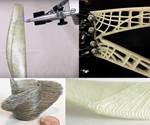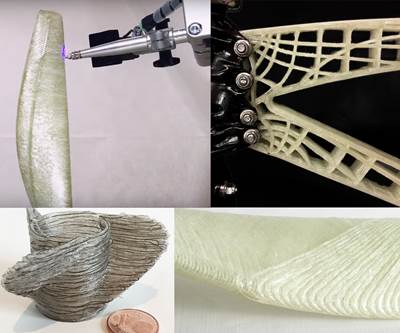Continuous Fiber Manufacturing blurs the line between 3D printing and AFP
Continuous fiber manufacturing (CFM) is a 3D printing/continuous fiber deposition process patented by moi composites.
Continuous fiber manufacturing (CFM) is the 3D printing/continuous fiber deposition process patented by moi composites (Milan, Italy). The company was established in February 2018 by materials engineer and professor Marinella Levi, design engineer Gabriele Natale and architect Michele Tonizzo. It was spun off from the +LAB, a collaborative 3D printing hub that Levi founded at the Politecnico di Milano.
CFM was patented in 2015 and demonstrated in 2016 through the Atropos project, which involved printing a continuous glass fiber/epoxy propeller blade using a Kuka industrial robot. The blade featured an internal truss and an exterior shell demonstrating both a multiaxial laminate (0°, 45°, etc.) and fiber placement along a nonlinear axis. Moi composites has developed a second-generation system using a Comau robot with a 1.0 × 0.5 × 0.8m height build envelope. “We have also used larger robots with rotary tables and larger build volumes, demonstrating that our technology is easily scalable,” says co-founder Tonizzo. “We currently can print with UV-cure in epoxy, acrylic and vinylester,” he says, “but we are not tied to UV curing.” Glass fiber up to 2400 tex and basalt fiber have both printed very well and moi composites is now working with carbon, though not with UV cure resins. The company can also print with electrically conductive fibers and is producing parts for biomedical, marine, oil and gas, and aerospace applications, mainly using glass fiber. It is also developing a third-generation, all-in-one print head with a system to apply pressure to the fibers, sensors, cutting mechanisms and a milling tool. Tonizzo says this will close the gap between 3D printing and automated fiber placement (AFP). “3D printing does not achieve the performance of AFP, but CFM offers more flexibility. We can already print with fibers 0.25-mm thick and have the ability to create curves and place continuous fibers in the ideal position,” he adds.
Hybrid processing is a concept moi composites has already explored, one of their successes being the Superior lightweight, low-deflection lower limb prosthesis. The prosthesis is made with a printed continuous glass fiber internal core which is then sheathed with a hand-layup, vacuum bag-only cured carbon fiber fabric and epoxy skin. “The whole design reduces deflection and increases customization while significantly cutting cost and production time,” says Tonizzo.
Part of this optimization is produced through the digital design and workflow, which uses Autodesk software with moi composites’ algorithms for stress and path optimization. This is what produces the optimized fiber path for both the structural loads and fiber deposition process.
CFM is open to a variety of materials and design innovations explored by +LAB, including 3D-printed infill patterns with a tunable elastic response, and printing with novel matrices like geopolymers, which behave like concrete. As moi composites continues advancing its CFM technology, will it sell print heads and machines? “Yes, but in the future,” says Tonizzo. “For now, we are producing parts and bringing the technology to the client's facility, using our know-how, print head and software to realize part solutions on demand. We are also seeking investors to further scale CFM machines and processes for commercial market opportunities.”
Read more in the blog | short.compositesworld.com/cfm_moi.
Related Content
The potential for thermoplastic composite nacelles
Collins Aerospace draws on global team, decades of experience to demonstrate large, curved AFP and welded structures for the next generation of aircraft.
Read MorePEEK vs. PEKK vs. PAEK and continuous compression molding
Suppliers of thermoplastics and carbon fiber chime in regarding PEEK vs. PEKK, and now PAEK, as well as in-situ consolidation — the supply chain for thermoplastic tape composites continues to evolve.
Read MoreThermoplastic composites welding advances for more sustainable airframes
Multiple demonstrators help various welding technologies approach TRL 6 in the quest for lighter weight, lower cost.
Read MoreManufacturing the MFFD thermoplastic composite fuselage
Demonstrator’s upper, lower shells and assembly prove materials and new processes for lighter, cheaper and more sustainable high-rate future aircraft.
Read MoreRead Next
Continuous Fiber Manufacturing (CFM) with moi composites
Continuous fiber 3D printing using epoxy, vinylester and acrylic with continuous glass, carbon, basalt and other fibers, including deposition along nonlinear curves, is only the beginning.
Read MoreFrom the CW Archives: The tale of the thermoplastic cryotank
In 2006, guest columnist Bob Hartunian related the story of his efforts two decades prior, while at McDonnell Douglas, to develop a thermoplastic composite crytank for hydrogen storage. He learned a lot of lessons.
Read MoreComposites end markets: Energy (2024)
Composites are used widely in oil/gas, wind and other renewable energy applications. Despite market challenges, growth potential and innovation for composites continue.
Read More

















.jpg;maxWidth=300;quality=90)








